#pigeon de nicobar
Text
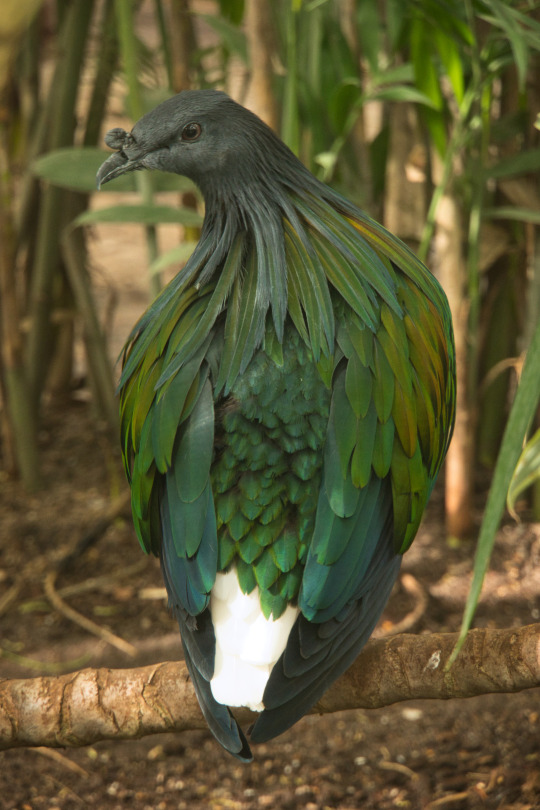
Pigeon de Nicobar - Habitant des forêts tropicales humides, des zones broussailleuses et des mangrove, il se nourrit essentiellement de fruits et de graines, ains que de petits insecte qu'il picore au sol.
Lieu : Pairi Daiza
#animaux#animals#animaux sauvages#wild animals#photo#photo animalière#animals photography#pigeon#bird#oiseau#pigeon de nicobar#nicobar à camail#nicobar pigeon
4 notes
·
View notes
Text
Yall hear about this in the news?
3 notes
·
View notes
Note
What do you think of companies like colossal, who are working to bring back the mammoth and thylacine, among others? I’m on their email newsletter list because I’m fascinated and feel the need to keep up with their progress but will it ever actually happen? I’m not convinced. Hopeful, but not convinced
Thanks for the ask! I hope you don’t mind if I ramble a bit, haha; as with all extinction stories, this is something that I have a lot of feelings about.
For as long as I can remember, the various Mammoth People have been making announcements like clockwork that we “will have a live mammoth within ten years!” The first time I heard it was, oh, about twenty-five years ago.
Back then, the plan was to clone directly from permafrost tissue; my understanding is that now the strategy has shifted to gene-editing an elephant to make it into a mammoth. I’ve also heard similar ideas thrown around about trying to make a thylacine out of a numbat or Tasmanian devil, or a Dodo from a Nicobar pigeon. At that point, I have to wonder what the point of it all is?
Professedly, we want to bring these animals back in order to heal the wounds we have left in the web of life. To have them step back into their places, as though they had never left. But how could a genetically-modified numbat or elephant ever fill such bespoke shoes? Even if we were capable of it, how would we even begin to “program” the instincts and behaviors of animals of which we know so little?
Do we, instead, simply want the satisfaction of seeing a lost animal standing in front of us (or at least, something that looks like one)? Anyone who loves extinct species is familiar with the hunger for photos, videos, sound recordings—anything, to see them. Will we be happy if science can present us with the living, breathing equivalent of a museum’s goose-feathered imitation Dodo? A Disneyland sort of creature, like Franklin Dove’s unicorns, with no natural place outside of some big budget exhibition?
(Has the existence of rebred Tarpans and Heck Cattle soothed the ache we feel when we look at cave paintings of ancient horses and bulls?)
Personally, I would jump at the chance to see an extinct animal be alive again, in any form or capacity. Even just seeing a realistic CGI reconstruction of a passenger pigeon flock, or a Steller’s sea cow, would absolutely thrill me. Selfishly, I can admit that I do just want to see them—to have that lost experience of knowing what it was like to look at these lost creatures. As long as I feel that way, I can’t judge de-extinction efforts too harshly.
The fact is, though, that DNA is much more fragile and complicated that anyone could have guessed during the first heady days of Jurassic Park.
When Celia, the last living bucardo died, the effort to clone her was already in progress. The team had so many factors on their side: tissue samples collected while Celia was still alive; an ideal proxy species to carry the cloned offspring; a thorough understanding of the biology and reproductive mechanisms of goats. It was as close to an ideal situation as could be hoped for. Nearly 300 embryos were created; a single one survived to term. That clone died minutes after birth, due to a malformation of her lungs, giving the bucardo the rare distinction of being the only animal to go extinct twice.
And that’s not even getting into the problems presented by the theoretical cloning of egg-laying animals (which also represent the majority of extinct species).
Technology progresses in ways we could never imagine. One day, I’m sure the things that these groups promise will be possible, and more; we’ll discover the cure for cancer, and the cure for regret. For the time being, though, de-extinction is a self-indulgent distraction. It’s attention-getting clickbait, at the expense of animals that are still here to save—a plan to raise the crumbling hulk of the Titanic, while ignoring a thousand other ships sinking around us without a lifeline.
I know some of the companies involved do state that they intend to use their discoveries and funding to benefit extant endangered species, but I don’t think it undoes the damage that is done every time a website runs a headline like, “This Company Is Bringing Back the Dodo by 2030!”. It all erodes the gravity of extinction in a way that greatly concerns me. The more times a person sees de-extinction presented as a simple, achievable matter, the closer they will come to the conclusion that, well, extinction isn’t forever. And if the loss of a species can be so easily reversed, then why should anyone be overly concerned about its prevention?
50 notes
·
View notes
Text
ok tipsy biologist tumblr opinion time: de-extinction is stupid
not for the "LOL juassic park tho" responses I always see because I think that shit is asinine and a non-issue
but. a) it's probably not feasible and even if it is, is your "mostly nicobar pigeon with some dodo DNA" really close enough to a dodo? does it fill that same ecological niche? probably not
and b) in conservation biology funding perspective it would take a truly stupid amount of money. you can't me the cost-benefit analysis of "wouldn't it be cool to see a wooly mammoth again" outweighs putting that money towards conserving existing species
like. recent extinctions are truly mind-numbingly depressing and it's hard for me to think about native hawaiian birds without wanting to cry. and I do really understand and empathize with the desire to bring them back but like. it's too late. we gotta fix what we can fix
#saw yet another deextinction startup article earlier#its just. we cant CRISPR our way out of everything fellas
0 notes
Text
Save the Eggs — The Next De-extinction Target: The dodo! Bird Reproduction Will Make Bringing The Dodo Back a Big Challenge.
— John Timmer | January 31st, 2023
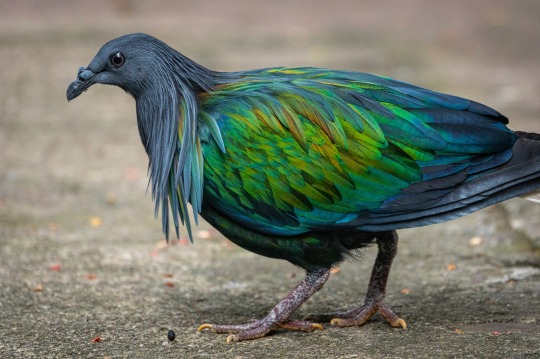
The Nicobar pigeon, the dodo's closest living relative, is quite a bit smaller and capable of flight.
Colossal is a company that got its start with a splashy announcement about plans to do something that many scientists consider impossible with current technology, all in the service of creating a product with no clear market potential: the woolly mammoth. Since that time, the company has settled into a potentially viable business model and set its sights on a species where the biology is far more favorable: the thylacine, a marsupial predator that went extinct in the early 1900s.
Today, the company is announcing a third de-extinction target and its return to the realm of awkward reproductive biology that will force the project to clear many technical hurdles: It hopes to bring back the dodo.
A Shifting Symbol
The dodo was a large (up to 1 meter tall), flightless bird that evolved on the island of Mauritius in the Indian Ocean. As European sailors reached the islands, it quickly became a source of food for them and the invasive species that accompanied them. It went extinct within a century of the first descriptions reaching Europe.
Its lack of fear for humans initially turned it into a metaphor for foolishness. But as concerns for human-caused extinctions and ecosystem disruptions have risen, the metaphor has shifted to one where the dodo represents a preventable tragedy caused by human thoughtlessness. It's that latter metaphor that made its de-extinction appealing to Colossal. "I think a lot of it is the name recognition," said Beth Shapiro, a biologist at the University of California, Santa Cruz, who's collaborating with Colossal. "You know, I think people don't really care about extinctions, in as much as it doesn't impact them personally. But the dodo somehow has this real draw to people.
"By targeting something that is so famous—really the icon of human-caused extinction—I think we're going to draw more people into thinking about it," Shapiro told Ars. (She's also collaborating on a separate project that's looking into de-extincting a second of these icons, the passenger pigeon.)
In the case of the thylacine and mammoth, Colossal made the case that returning these keystone species to the habitats they once inhabited will alter the habitat significantly, changing which species can survive and thrive there. The company's argument for restoring the dodo is, in many ways, the converse: We will have to restore the ecosystem before a revived dodo can survive there.
"If [dodos] are to be able to reestablish thriving populations on Mauritius, it's going to require removing many of the invasive species that were introduced there. And in that way, this project will help to reinvigorate and revive these ecosystems," Shapiro said. "By making sure that dodos can survive there, we'll have to create a habitat that is also beneficial to other endemic Mauritian flora and fauna that maybe are struggling to survive because of the invasive species rather than because of the absence of dodos."
Technical Hurdles
The dodo is also a new direction in a biological sense, in that it's a bird. In mammals, things like cloning, gene editing, and other manipulations are done all the time and have been used successfully in various species. Birds, partly because of their use of eggs, require different techniques—techniques that haven't been as thoroughly developed or widely deployed. In fact, they've only been used in a single species, the domestic chicken.
The techniques developed there are dramatically different from what's available in mammals. In chickens, we don't have stem cells that can reconstitute an entire embryo, and it's not clear that we could use them anyway, given that the initial development of the embryo is so closely tied to egg production. But we do have what are called primordial germ cells (PGCs) that act a bit like stem cells—they can divide indefinitely in culture dishes—but are committed to only forming germ cells, which go on to produce eggs and sperm.
During normal chicken development, the primordial germ cells migrate through the circulatory system and reside in the developing gonad. PGCs can be manipulated in culture and then moved from the culture dish to the circulatory system at this stage, allowing them to form genetically engineered germ cells and give rise to offspring that carry the same engineering. This works partly because of the egg; a small hole can be opened, the PGCs transferred, then the hole can be taped over and the chicken embryo can continue to develop.
However, we don't know whether these techniques work well or at all in species beyond chickens. Or whether PGCs from one species can successfully enable reproduction when transplanted into a different one. Or how size mismatches between eggs and developing embryos work out. Or any of a large number of additional questions. So, it's possible that the technology development needed to enable the dodo de-extinction could hit a brick wall well before trying to engineer any dodo-like DNA sequences into its closest living relatives, the Nicobar pigeon.
Worth The Effort?
For several reasons, Colossal sees the risks as being worth the effort. One of these reasons is simply its business model, which involves recognizing when the technologies needed for de-extinction can be useful in medicine, biotechnology, or agriculture. Many species of birds are raised commercially, and it's possible that streamlining PGC manipulations and enabling them in other commercial species could generate revenue for Colossal.
Developing these technologies for birds is also in keeping with Colossal's interest in ecosystem restoration. "We're losing a lot of birds, which are really, really critical to ecosystems, and there's just not enough money going into it," Colossal's Ben Lamm told Ars. "We could start working on the dodo while further developing some of these underdeveloped and underfunded technologies around bird conservation."
— John Timmer is Ars Technica's Science Editor. He has a Bachelor of Arts in Biochemistry from Columbia University, and a Ph.D. in Molecular and Cell Biology from the University of California, Berkeley. John has done over a decade's worth of research in genetics and developmental biology at places like Cornell Medical College and the Memorial Sloan-Kettering Cancer Center. He's been a speaker at the Nobel Dialogs, the annual meeting of the National Association of Science Writers, and the Science Online meetings, and was one of the organizers of the SONYC discussion series. John has taught scientists how to communicate with each other and the public at Cornell Medical College and Stony Brook University. When physically separated from his keyboard, he tends to seek out a bicycle, or a scenic location for communing with his hiking boots.
1 note
·
View note
Photo

[Image ID: Illustration by George Shaw, “Dodo” (published in 1809; now in public domain) (taxonomic nomenclature of the Dodo: Raphus cucullatus)]
[The last accepted sighting of a Dodo was in 1662—361 years ago]
A 'De-Extinction' Company Wants to Bring Back the Dodo
[...] Founded in 2021 by tech entrepreneur Ben Lamm and Harvard University geneticist George Church, the company [Colossal Biosciences] first said it would re-create the mammoth. And a year later it announced such an effort for the thylacine, aka the Tasmanian tiger. Now, with the launch of a new Avian Genomics Group and a reported $150 million of additional investment, the long-gone dodo joins the lineup.
In the world of extinct animals, the dodo carries some heavy symbolic weight. Native to Mauritius in the Indian Ocean, it went extinct in the mid- to late 17th century, after humans arrived on the island. The ungainly bird, which stood around one meter tall and weighed about 15 to 20 kilograms, represents a particular kind of evolutionary misfortune: It should have been afraid of humans, but it wasn’t. The birds blithely walked up to sailors, so received history goes, and didn’t flinch as their peers were killed around them. The dodoes, which reproduced by laying a single egg on the ground, were also predated by other species, such as monkeys and rats, which humans brought with them. Now the creature represents extinction itself—you can’t get deader than a dodo.
“This announcement is really just the start of this project,” says Beth Shapiro, lead paleogeneticist and a scientific advisory board member at Colossal Biosciences. Shapiro, also a professor of ecology and evolutionary biology at the University of California, Santa Cruz, has studied the dodo since the science of paleogenetics was in its infancy. In 2002 she published research in Science describing how her team had extracted a tiny piece of the bird’s mitochondrial DNA (mtDNA)—the DNA inside little organelles called mitochondria that gets passed down from mother to offspring. That snippet of mtDNA showed the dodo’s closest living relative was the Nicobar pigeon. Then, in 2022, Shapiro announced that her team at U.C. Santa Cruz had reconstructed the dodo’s entire genome.
[article continues at Scientific American]
#bird#birds#birdwatching#birding#birb#birbs#birdblr#birblr#nature photography#wildlife photography#bird photography#ornithology#borb#borbs#birdcore#birbcore#borbcore#dodo#dodo bird#de-extinction#DNA#extinct animals#mauritius#Raphus cucullatus#george shaw#science#mtDNA#extinction#Colossal Biosciences#extinct
1 note
·
View note
Note
Favourite music genre & favourite animal?
Music genre: this is so hard to pin down because I listen to so many different kinds of music and my "favourite" rotates with my mood lol but if I'm always good for alt rock/indie rock... some of my favs are City Mouth, The Sonder Bombs and Des Rocs
Favourite animal: uhhhh pigeons I think. Specifically the Nicobar pigeon because it looks like a professor at a magic school

4 notes
·
View notes
Text
I just had one of the best days of my life.
I went to the Parc des Oiseaux (Bird Park) of Villars-les-Dombes with a friend and we spent the entire day there and it would be impossible to talk about everything we did and every bird we saw so I’ll just say this:
-at some point I had 4 Lorikeets on me that I was feeding and one tried to steal my necklace and 2 others started fighting
-I got to pet a Kookaburra which was something I wanted to do ever since I read the words “Sausage-addicted kookaburra too fat to fly” in a headline
-in the part of the park dedicated to Australian birds there were also Wallabies that just walk around and go nap under trees next to you ?? a complete surprise but a very nice one
-I FINALLY got to be face to face with the biggest pigeon in the world aka the Victoria Crowned Pigeon which is something I’ve been dreaming of for years, and I also saw a ton of other cool pigeons including the Nicobar Pigeon and the African Olive Pigeon
My life is complete
#it was AMAZING#wayy better than anything I expected#there was a show at 2pm where they made birds fly right above our heads and in front of us while music was playing#and a voice over talked about the birds and their behavior and natural habitat#I loved every second#my life#bee tries to talk#birds
14 notes
·
View notes
Photo
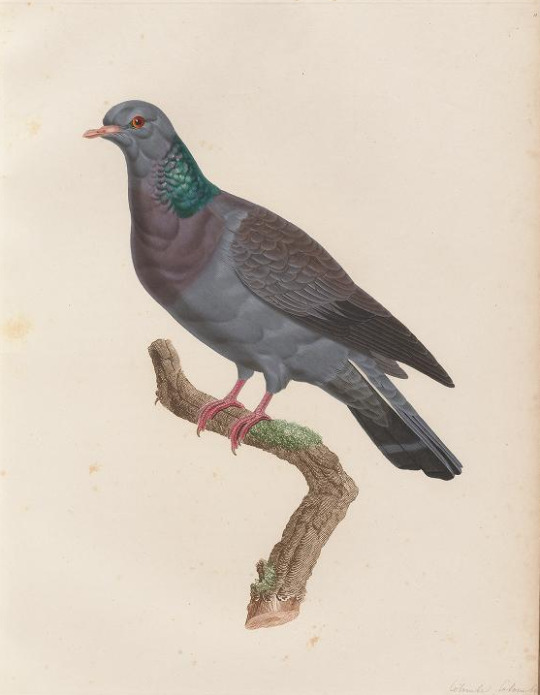
BHL Book Feature: Les Pigeons!
The pigeon -- an amusement to those in urban areas who like feeding them and seeing nature among skyscrapers, and a bane to those who have the unfortunate task of cleaning up after them. This week, we are taking a look at the world of pigeons and doves in a newly digitized book, Les Pigeons (1811) by Coenraad Jacob Temminck with illustrations by Pauline de Courcelles Knip.
Family Columbidae has 310 species of pigeons and doves! What usually comes to mind when we think of pigeons are the domesticated variety which were bred from Rock Pigeons (Columba livia) or the common Stock Pigeon (Columba oenas), which is our featured illustration. But among those 310 species (and the fancy domesticated breeds), there are plenty of splendid pigeons that rival the notion that pigeons are dull and boring.
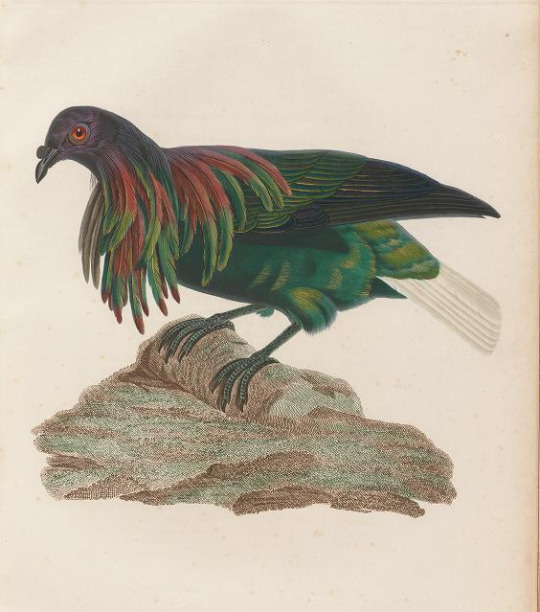
The Nicobar Pigeon (Caloenas nicobarica) is native to small islands in southeast Asia, and it is the closest living relative to the Dodo!

The Blue-crowned Pigeon (Goura cristata) is endemic to the lowland rainforests of Papua New Guinea, and on average, it is over 2 feet long and weighs over 4 pounds. This species and the two others in the genus Goura (the Southern Crowned Pigeon (Goura scheepmakeri) and the Victoria Crowned Pigeon (Goura victoria) are the largest living pigeons.
For #Feathursday, we will share the high drama of the pigeon world -- at least that is when humans get involved! Les Pigeons (1811) by Coenraad Jacob Temminck and illustrated by Pauline de Courcelles Knip was contributed for digitization by the Ernst Mayr Library of the Museum of Comparative Zoology of Harvard University.
#Pigeons#Les Pigeons#BIRBS!#Feathursday#Ernst Mayr Library#BHLib#Biodiversity Heritage Library#Birds#Ornithology
24 notes
·
View notes
Photo
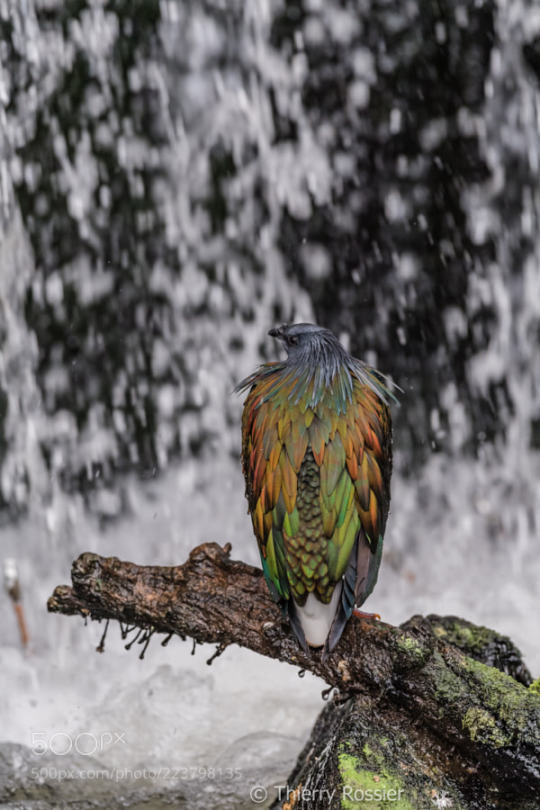
http://goo.gl/plM6ud Oh mon beau pigeon Pigeon de Nicobar en pleine séance de méditation? by ThierryRossier
#water#beautiful#drop#zen#animal photography#bird pictures#Caloenas nicobarica#Nicobar#Nicobar Pigeon
0 notes
Text

Piegon de Nicobar - C'est l'un des plus proches parents du dodo. Il est facilement reconaîssable par son plumage bleu et vert, unique pour les pigeons.
Lieu : Zoo d'Amiens Métropole
#jardin#garden#animaux#animals#animaux sauvages#wild animals#photo#photo animalière#animals photography#pigeon#bird#oiseau#pigeon de nicobar#nicobar à camail#nicobar pigeon
0 notes